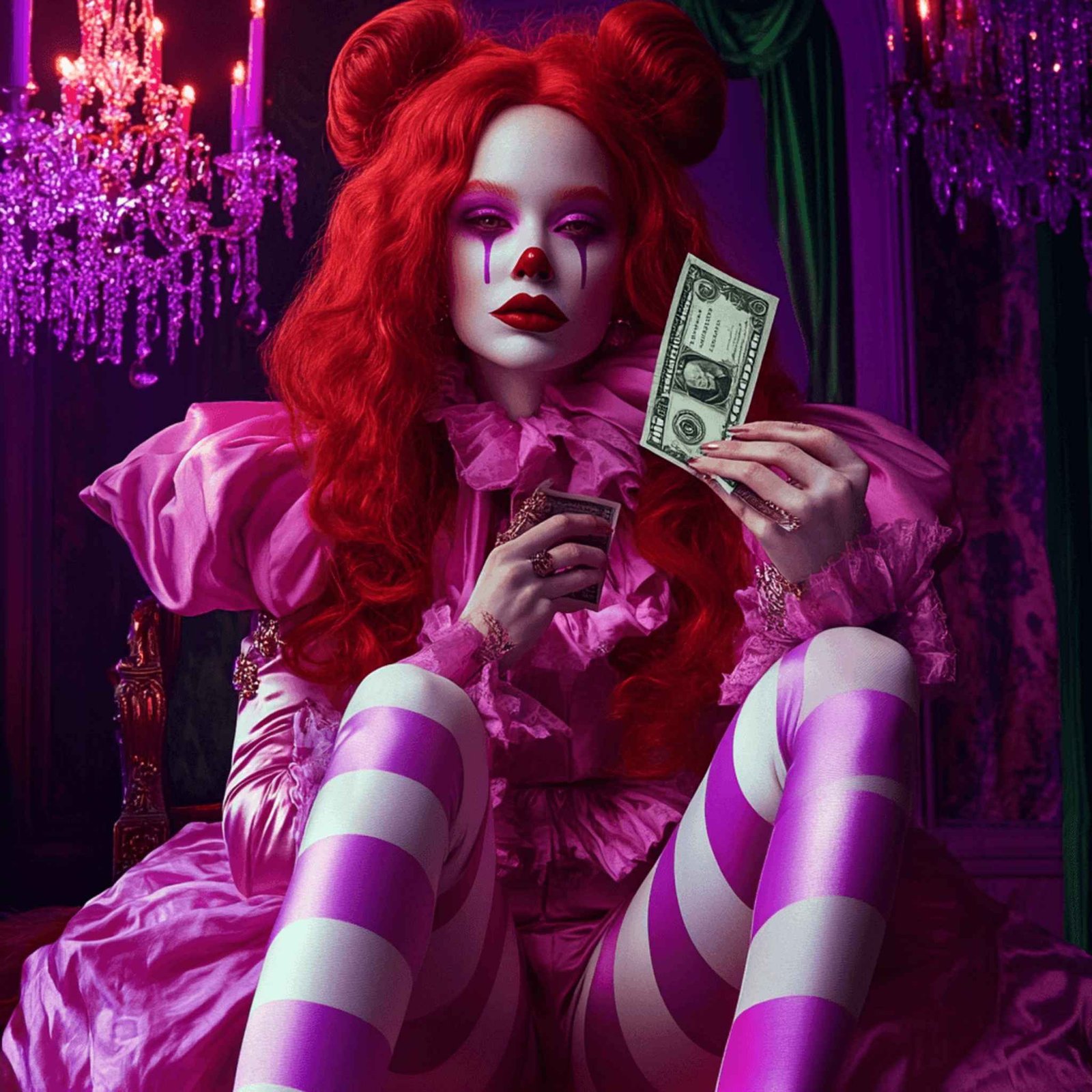Description
Introduction to the Work of Art: A Portrait of Wealth, Power, and Play
In Avaritia facit bardus AZ41, a woman dressed in extravagant, voluminous pink satin gazes out with an expression of calculated indifference. Her flaming red hair, styled into two tight buns, sits like crowns atop her head, an unapologetic declaration of power. Her posture—legs casually draped, striped in pink and white—dominates the space. In her hand, she holds a single dollar bill, casually raised as though its value is ambiguous, almost laughable. Behind her, an elaborate chandelier hangs from the ceiling, casting a violet glow over the scene. This opulent room is rich with decadence, the dark corners filled with velvet textures and glossy reflections. The woman’s makeup is theatrical, her features exaggerated into a doll-like mask that mixes innocence with command, highlighting the contrast between beauty and something darker beneath.
This striking piece, Avaritia facit bardus AZ41, belongs to AZAD 777781’s renowned Avaritia facit bardus series, exploring human greed, desire, and the intoxicating lure of wealth. The Latin title, translating to “Greed makes fools,” sets the tone for a portrait that intertwines power and absurdity. In this work, AZAD presents a figure of wealth and allure, but one whose power and beauty are tainted by a sense of theatrical detachment from the world around her. The dollar bill becomes a symbol of her relationship with money—not a source of joy, but a mere tool in the elaborate game of status and control.
Exhibition Introduction: Beauty, Wealth, and the Performance of Power
In the dazzling glow of wealth, where every glance, every smile, and every gesture is an act, AZAD 777781 invites viewers into the world of Avaritia facit bardus AZ41. Here, money is not merely currency; it is performance, it is seduction, it is power. Draped in the soft sheen of pink satin, this central figure—part clown, part queen—rules her opulent domain, but at what cost?
The woman in this artwork embodies the duality of beauty and power, but AZAD’s treatment of her is far from idealized. Her doll-like features and extravagant costume suggest both the seduction and artifice of wealth. She is a figure deeply entrenched in materialism, but there is something performative in her posture, something that hints at an inner detachment from the very wealth she controls. The exaggerated redness of her hair, the deep violet eyeshadow, and the contrasting soft pink of her costume all work together to create a striking visual that speaks to themes of control, excess, and the falseness of outward appearances.
There is an almost dreamlike quality to the composition, with the rich textures and soft lighting creating an atmosphere that feels both decadent and claustrophobic. The chandelier, its crystals glowing with a violet hue, casts reflections and shadows that blur the boundaries between reality and fantasy, suggesting that this figure’s world is as much a stage as it is a space of power. The dollar bill she holds—raised casually but deliberately—is a symbol not just of wealth, but of her mastery over the illusion of wealth. She commands it, but she is also, in some ways, enslaved by it.
AZAD’s use of the figure of a clown, combined with the woman’s beauty, adds layers of meaning to the work. The clown, traditionally a figure of humor and absurdity, becomes a symbol of the theatrical nature of power and wealth. The woman’s painted face, with its stark white foundation, deep red lips, and large, expressive eyes, suggests that she is not just a participant in this world of material excess, but a performer in a larger, more grotesque spectacle. She is both the object of desire and the one who wields desire as a tool, but there is a sense of tragedy in her performance—a recognition that, despite her power, she is ultimately playing a role that she cannot escape.
Art Critique: The Influence, Technique, and Meaning of the Work
AZAD 777781’s Avaritia facit bardus AZ41 is a masterful blend of visual storytelling and technical innovation. The textures in this piece—from the satin sheen of the woman’s dress to the soft, almost tangible glow of the chandelier—are rendered with such precision that they invite the viewer to linger in the rich details of the composition. Yet, for all its beauty, there is something unsettling about the image. The woman’s exaggerated features and the stark contrast between her theatrical makeup and the luxurious setting create a tension that speaks to the dissonance between outward appearance and inner reality.
The use of color in AZ41 is particularly striking. The deep purples, reds, and pinks that dominate the composition create an atmosphere that is both sensual and ominous, evoking the tension between seduction and control. The pink stripes on the woman’s stockings, echoed in the soft glow of the lighting, create a visual harmony that draws the viewer’s eye toward her figure, but the overall effect is one of surreal distortion. The woman, while beautiful, feels almost like a doll or a puppet—her exaggerated features and rigid posture suggesting that she is not fully in control of her own narrative.
AZAD’s work draws heavily on the traditions of surrealism and figurative expressionism. His use of exaggerated features and theatrical settings recalls the work of 20th-century artists such as Salvador Dalí and Francis Bacon, both of whom used distortion to explore deeper truths about the human condition. Like Dalí and Bacon, AZAD’s figures are grotesque in their beauty, their exaggerated features and surreal environments serving as metaphors for the inner struggles of desire, greed, and power.
The influence of caricature is also evident in AZAD’s work. The woman’s painted face, with its stark white foundation and dramatic red makeup, recalls the exaggerated features of classic caricature, but AZAD uses this distortion not to mock, but to reveal the absurdity of the figure’s relationship with wealth and power. The dollar bill she holds becomes a symbol of her complicity in the performance of materialism, while also serving as a reminder of the ways in which wealth can distort both our sense of self and our relationships with others.
The technique used in this piece—a combination of digital and traditional media—allows AZAD to create a composition that feels both hyper-real and deeply surreal. The textures, lighting, and colors are rendered with such precision that they seem almost tangible, yet the overall effect is one of dreamlike distortion. The woman’s figure, while beautiful, feels almost artificial, her exaggerated features and theatrical costume suggesting that she is both a participant in and a victim of the performance of wealth.
Artistic Critic Presentation: The Vision of AZAD 777781
AZAD 777781 is a digital artist known for his ability to explore the darkest corners of the human psyche through the lens of figurative expressionism. His work often features exaggerated figures and surreal environments that serve as metaphors for the fears, desires, and obsessions that define the human experience. In Avaritia facit bardus AZ41, AZAD continues his exploration of greed, materialism, and power, using the figure of the woman to critique the ways in which wealth distorts both our sense of self and our relationships with others.
AZAD’s work is notable for its ability to evoke empathy for his characters, even as they are depicted in exaggerated and often grotesque forms. The woman in AZ41 may be a figure of wealth and power, but she is also deeply human, reflecting the universal struggles of desire, control, and the search for meaning in a world that is increasingly dominated by materialism.
Through his use of surreal imagery and exaggerated figures, AZAD challenges viewers to confront the ways in which wealth and power shape their own lives, turning them into performers in a grand, often grotesque, spectacle. His work is not just a critique of greed and materialism—it is a reflection on the deeper human need for connection, meaning, and fulfillment.
Artistic Critic Presentation: The Poetic Themes of Avaritia facit bardus AZ41
“Avaritia facit bardus AZ41” is a poetic exploration of the complex relationship between beauty, wealth, and power. At the heart of the piece is the figure of the woman, whose doll-like features and extravagant costume serve as both a symbol of material wealth and a critique of the ways in which beauty is commodified in a materialistic society.
The woman, while visually striking, is also deeply tragic. Her posture, though confident, suggests a kind of detachment from the world around her. The dollar bill she holds becomes a symbol of the power dynamics that define her relationships, turning even the most intimate moments into transactions. Her beauty, while undeniable, is also a mask—an outward performance that conceals the emptiness beneath.
The clown-like elements of the woman’s appearance add layers of meaning to the work. The exaggerated makeup, the painted smile, and the theatrical pose suggest that she is not just a participant in this world of material excess, but a performer in a larger, more grotesque spectacle. She is both the object of desire and the one who wields desire as a tool, but there is a sense of tragedy in her performance—a recognition that, despite her power, she is ultimately playing a role that she cannot escape.
The setting of the piece, with its rich textures and soft lighting, creates an atmosphere that is both luxurious and claustrophobic. The chandelier, glowing with a violet hue, casts long shadows across the room, suggesting that this world of wealth and power is as much a prison as it is a paradise. The woman, though seated on a throne of luxury, is ultimately isolated, her relationships defined by the currency she holds rather than the connections she seeks.
AZAD’s use of color in this piece is particularly powerful, with the deep purples, pinks, and reds creating a visual harmony that is both beautiful and unsettling. The contrast between the woman’s extravagant costume and the dark, shadowy background highlights the tension between appearance and reality, between beauty and the darker forces that shape our desires.
Through Avaritia facit bardus AZ41, AZAD invites viewers to reflect on the ways in which wealth and power shape their own lives, turning them into performers in a grand, often grotesque, spectacle. The woman, while captivating in her beauty and power, is also a tragic figure—caught in a cycle of desire and control that ultimately leaves her isolated and disconnected from the world around her.
Conclusion: Beauty, Wealth, and the Performance of Power
In Avaritia facit bardus AZ41, AZAD 777781 has created a work that is both visually stunning and deeply philosophical. The woman, seated in her opulent throne, becomes a symbol of the ways in which wealth and power distort our relationships, turning love and passion into transactions, and beauty into a performance. Through his masterful use of color, light, and texture, AZAD has created a scene that is both seductive and unsettling, drawing the viewer into the intimate drama of the character’s interaction with wealth.
This work is not just a critique of greed and materialism; it is a reflection on the deeper human desire for connection, meaning, and fulfillment. The dollar bill held by the woman serves as a reminder that even the most intimate moments can be shaped by power and wealth, reducing human connection to a transaction. AZAD’s ability to express these complex themes through his unique visual language is what makes him one of the most compelling artists of our time.
Through Avaritia facit bardus AZ41, AZAD challenges us to look beyond the surface of our own lives, to question the values and desires that drive us, and to recognize the ways in which we are all players in the game of wealth and desire, often trapped in roles that leave us longing for something more. It is a work that invites deep reflection and offers no easy answers, but it is in this complexity that the true power of AZAD’s art lies.





